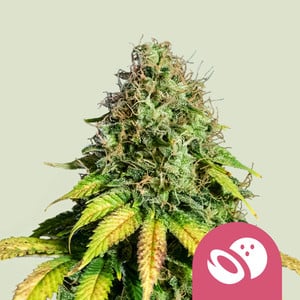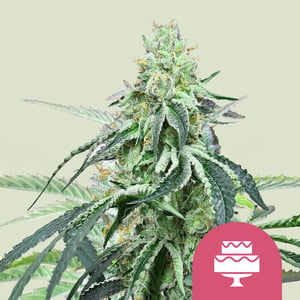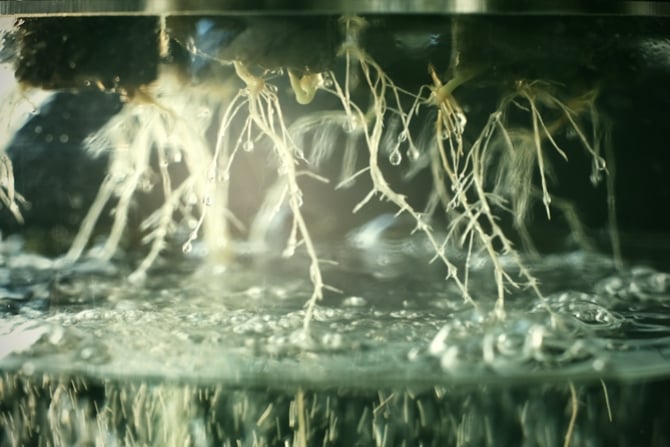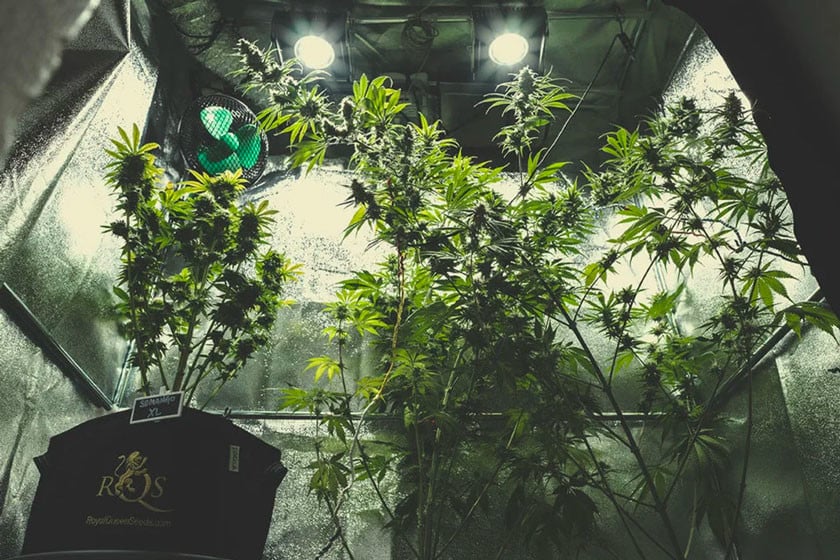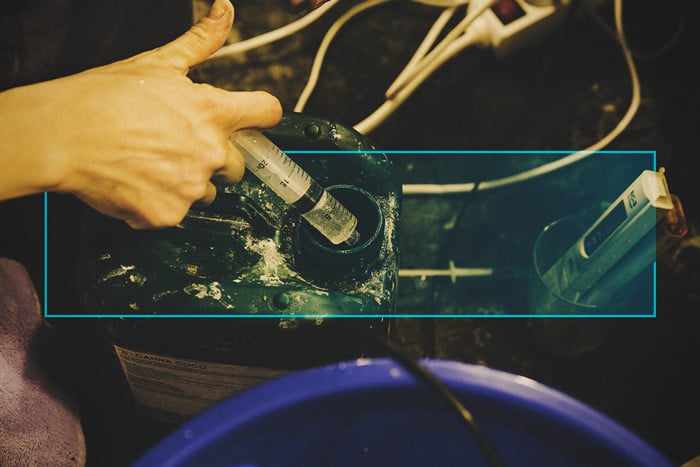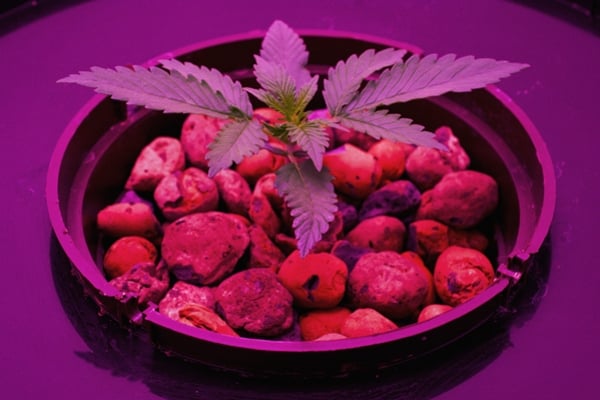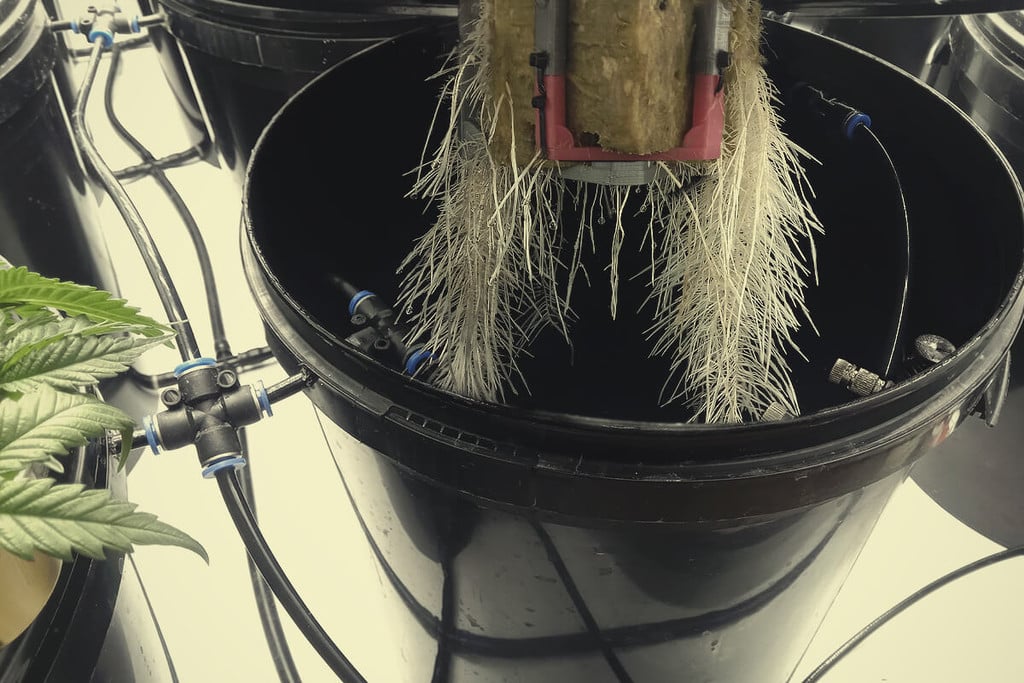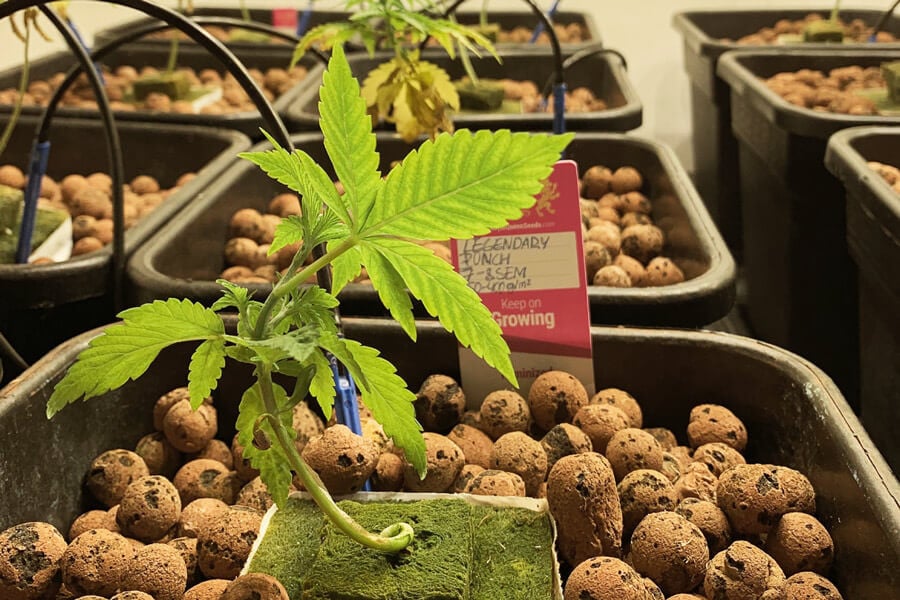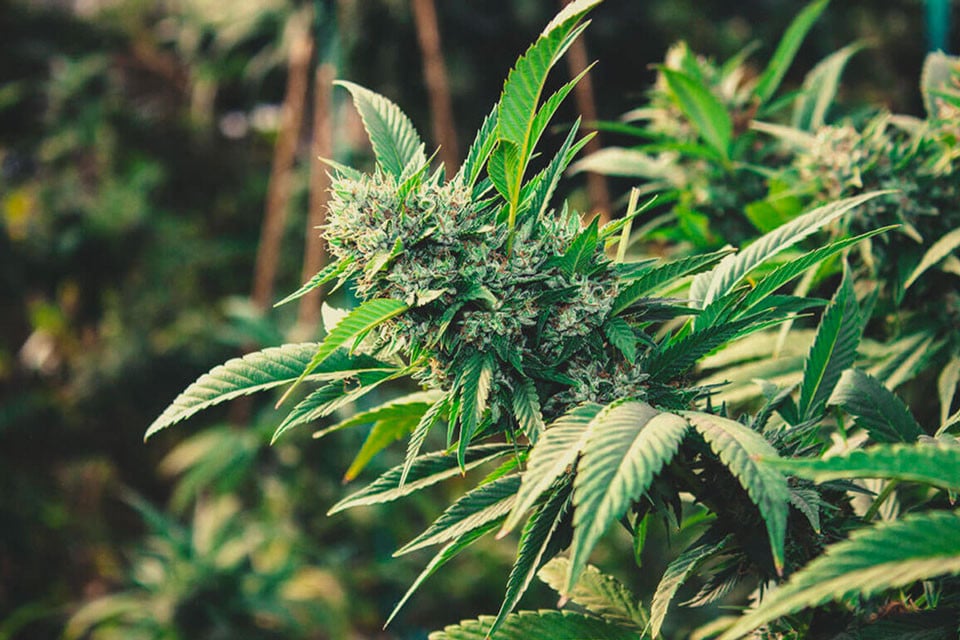.
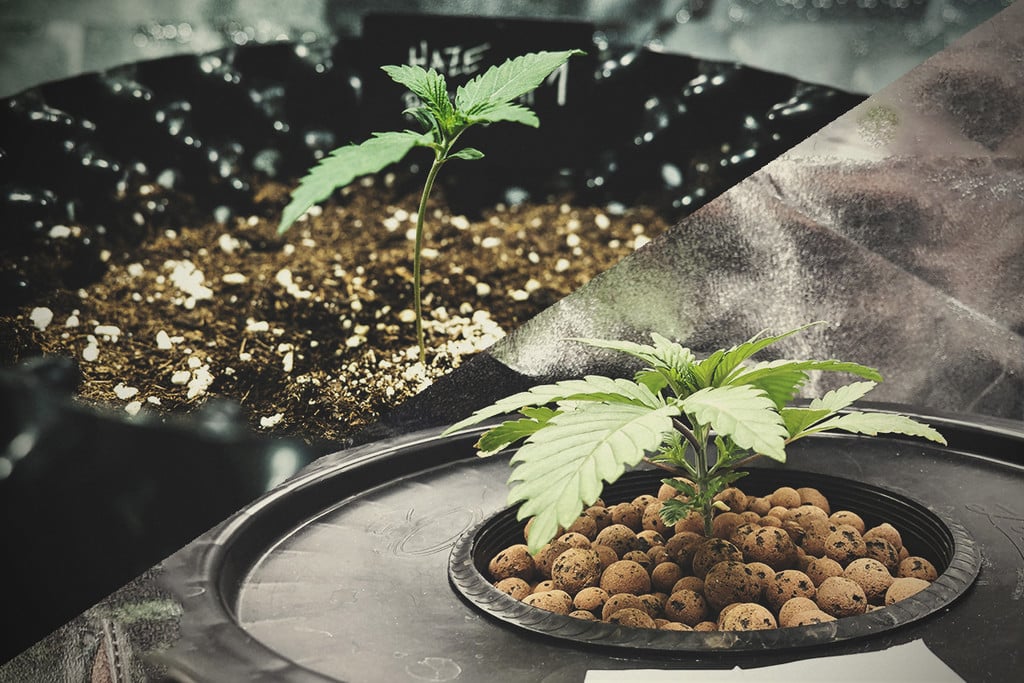
Hydroponic vs Soil Cannabis Cultivation
Whether you're about to grow weed for the first time or have years of experience, it helps to know the key differences between soil and hydro. You can achieve excellent results using both techniques, but they differ dramatically when it comes to feeding and overall management. Here's what you need to know.
Contents:
There’s more than one way to grow cannabis. Despite the variety of options, essentially all techniques fall into one of two categories: soil or hydroponics. Both cultivation methods are capable of producing healthy and productive cannabis plants, but require different equipment and management practices.
In soil growing, cannabis roots receive nutrients from organic matter and minerals in the soil, with help from microbes and the soil food web. In contrast, the roots of hydroponic plants extend into either air or water, receiving key nutrients through liquid solutions during constant or intermittent feeds.
Hydroponic techniques are often deemed a modern invention, but this form of agriculture spans back to the Hanging Gardens of Babylon and the Floating Gardens of China. Soil-only purists sometimes disregard hydroponic cultivation as an unnatural method that doesn’t allow cannabis plants to reach their full potential. But in truth, both soil and hydroponic techniques can render equally superb results, despite their differences. The end product all depends on dialling in environmental conditions, meeting the nutritional and light requirements of plants, and selecting high-quality genetics from the get-go.
Soil and hydroponic cultivation are umbrella terms that cover a wider range of techniques. Soil cultivation encompasses sowing directly in the ground outdoors and growing in containers both indoors and out, and comprises practices and schools of thought including no-till, hugelkultur, and many others. Hydroponic growers also have a range of options to choose from, including deep water culture (DWC), ebb and flow, bubbleponics, aeroponics, and others.
Comparing Soil and Hydroponic Cannabis Growing
Below, we delve into the differences between soil and hydroponic growing. We’ll compare growing media, environment, nutrients, quality, difficulty, and everything else you need to know.
Germination, Transplanting, and Harvesting
⇢ Germination
All cannabis grows (apart from taking cuttings) start with germination. Soil and hydro growers can start seeds in the same way, or use techniques exclusive to each method.
To start, growers from both disciplines can use the glass of water or kitchen towel method before moving seeds into containers of soil or net pots of inert medium.
Soil growers have the option of sowing seeds directly into their final containers or garden plot, or they can sow into soil plugs before transplanting later on. On the other side, many hydro growers choose to sow into Rockwool cubes that slot into net pots, which are then inserted into hydroponic systems.
⇢ Transplanting
Once germinated, hydro plants typically remain in the same net pot and hydroponic system for the duration of the growing cycle. Soil growers, however, tend to transplant more often, depending on their preferences. Some swear by sowing seeds directly into their final home, whereas others transplant them into larger containers over time to give them room to develop a more expansive root system.
⇢ Harvesting
There are virtually no major differences in harvesting soil vs hydroponic plants. Growers can opt for wet or dry trimming with either method, and both require you to cure your buds sufficiently before sampling.
Growing Medium
The growing medium used is one of the major differences between soil and hydroponic cultivation. The term “medium” refers to a substrate used to sustain the life of a plant.
As the name suggests, soil growing uses soil to supply vital nutrients to cannabis plants. Roots uptake macronutrients and micronutrients via the process of diffusion. Some soil growers administer synthetic nutrients that plants are able to uptake immediately. Others rely on organic matter within the soil. Over time, soil organisms help to unlock the nutrients within organic matter and make it available to plants.
Water serves as the nutritional medium in hydroponics. However, plants also need structural support in the area between the root zone and stem to keep them upright in their net pots, for instance. Growers use substrates such as Rockwool, coco coir, or clay pebbles for this purpose. Instead of soil, roots are constantly or intermittently exposed to a solution containing all of the nutrients required to cultivate healthy specimens.
Some systems, such as DWC, constantly submerge roots in water and use air stones to ensure the roots receive a steady supply of oxygen. Other methods, such as ebb and flow, only periodically bathe roots in nutrient solution, allowing them to breathe in between feeds.
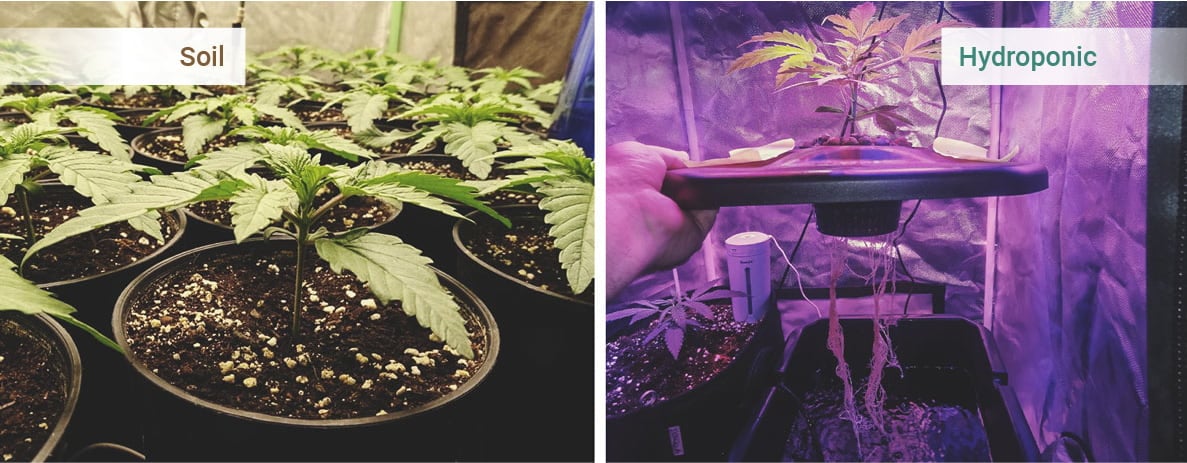
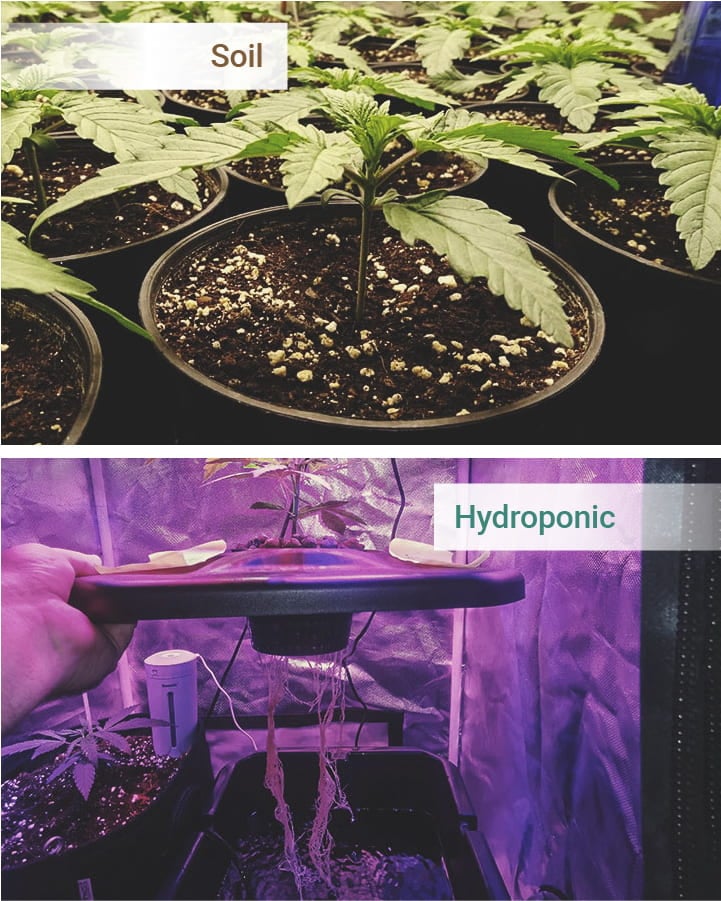
-
Nutrition: Micronutrients and Macronutrients
Cannabis plants require specific minerals and elements in order to grow and survive. These substances fall into two major categories: macronutrients and micronutrients.
As the name suggests, macronutrients are needed in larger quantities. The three main macronutrients for weed are nitrogen, potassium, and phosphorus (NPK). Though vital throughout all stages of growth, the cannabis plant’s demand for each nutrient changes throughout its growing cycle. For example, vegging plants require more nitrogen, whereas flowering plants demand higher levels of phosphorus.
Micronutrients also help plants to fulfill key physiological processes, but they’re required in smaller quantities. These include boron, zinc, manganese, iron, copper, molybdenum, and chlorine.
Although cannabis plants grown in soil and hydro require the same nutrients, how these nutrients are administered, and in what form and quantities, differs—potentially dramatically.
⇢ Soil
Soil growers differ in their approach to feeding their weed. Some use only organic matter—such as manure, straw, woodchips, and compost—as a source of nutrients. These materials break down slowly over time to provide a wide spectrum of nutrients. While an effective and sustainable option, organic matter doesn’t contain immediately available nutrients, so starting with high-quality soil is key if employing this method.
Other soil growers use techniques such as Korean natural farming (KNF) to create plant ferments—applied as either a foliar spray or root drench—to supply a broad spectrum of minerals.
Many soil growers choose to go down the synthetic route, using veg and flowering formulas of liquid or powdered nutrients that are immediately available to plants, and administered according to a specific schedule.
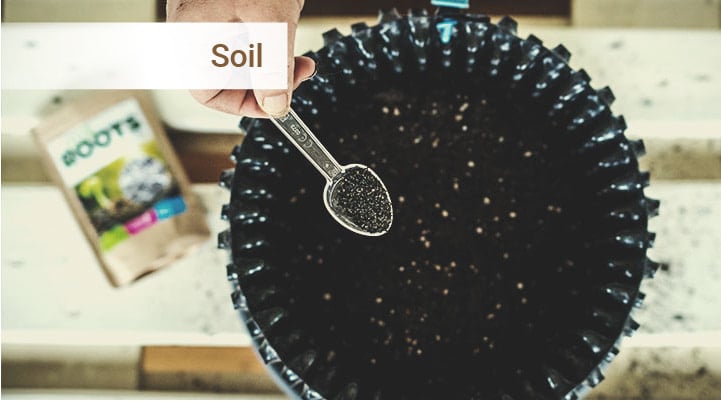
⇢ Hydro
Hydroponic growers also have both organic and synthetic options when it comes to delivering the correct amounts of nutrients to their plants.
Most hydro growers use bottled formulas containing optimal quantities of these substances. Whereas soil growers can sometimes get away with feeding too much or too little—due to the buffering nature of the soil—hydro growers can’t. Aside from trace minerals, your water doesn’t inherently contain the nutrients plants need. However, not all hydro growers rely entirely on commercial nutes. Some use fish manure as a source. Aquaponics, a form of hydroponics, uses connected tanks of live fish to dispense manure directly to their crops.
Whereas soil growers deliver organic matter or liquid feeds into the soil (or onto the leaves), hydro growers administer nutrient formulas into a reservoir. The most basic hydro systems, such as the Kratky method, only contain a single container to which nutrients are directly added. However, methods such as recirculating DWC require growers to add nutrients into an external reservoir. A pump then distributes the solution to plants through a network of pipes.
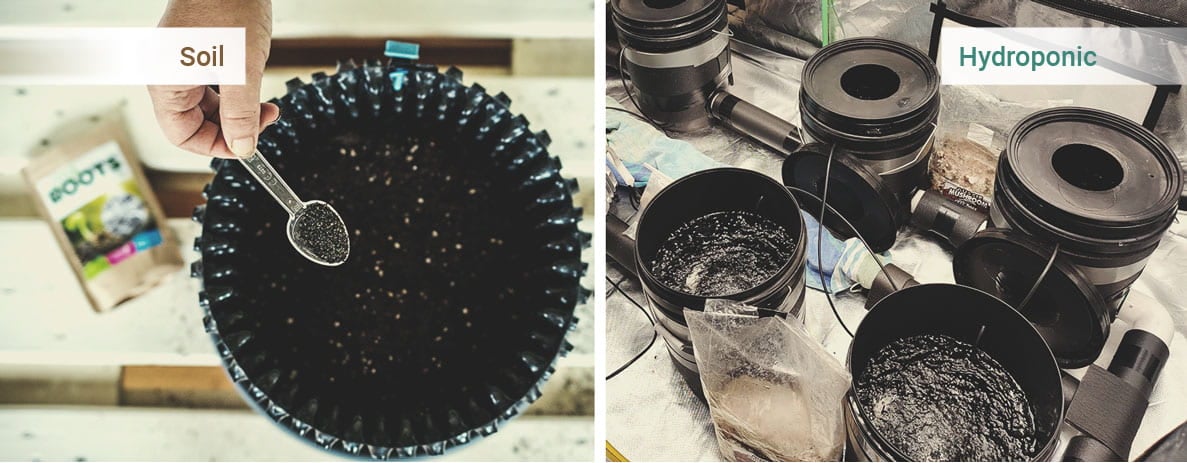
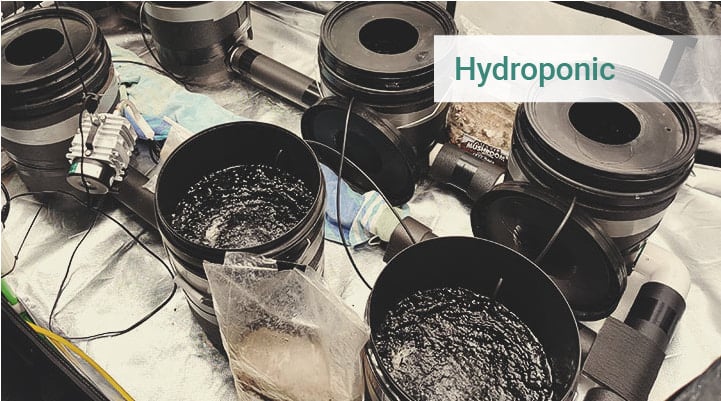
-
Growing Environment
Despite their differences, both soil and hydro-grown cannabis plants require the same environmental conditions, demanding certain ranges of relative humidity and temperature throughout the seedling, vegetative, and flowering stages. Stage-specific parameters aside, hydro and soil plants can thrive both indoors and outdoors.
⇢ Indoors
Growing indoors gives cultivators almost complete control over environmental factors, including lighting and watering. Indoor growers using hydro or soil are also less likely to encounter pests if integrated pest management techniques, such as insect screens and good hygiene procedures, are adopted. That said, soil-grown plants are still at a greater threat of pest issues overall, regardless of the environment. Moreover, hydro growers using coco coir as a structural medium can fall victim to coco-specific pests.
⇢ Outdoors
Hydro and soil-grown plants can also flourish equally well outdoors. Here, growers face more challenges in terms of adverse weather, pests, and disease. Hydro growers can also run into problems with reservoirs getting too hot during heat waves, but shade cloth and placing plants in a partially sunny spot can help to offset this issue.
Most outdoor growers choose to go with soil, as many gardens offer a free growing medium, or at least free space, in the ground. However, growing in a container, using soil or hydro, is a good option if you’re dealing with limited space or a garden covered in gravel or concrete.
Soil vs Hydroponic Cannabis: Making a Choice
Now that you’re more familiar with the differences and similarities between soil and hydro growing, let’s dive a little deeper into how they compare when it comes to choosing one over the other. In what follows, we touch on differences in price, space, difficulty, and flower quality. By the end of this section, you’ll be able to make a more informed decision about which cultivation method to proceed with.
-
Price
The price of a cannabis grow depends on a host of different variables. For example, if following a no-till method, it will cost a lot more to use soil if you need to cover a large area with compost at the end of every season than it will to grow a single plant using the Kratky method. The price of growing a single plant in soil will also vary depending on whether you grow indoors or outdoors, due to the cost of a grow tent, lighting, and other investments.
On the other hand, if you’re only growing a couple of plants, cultivating outdoors in the ground or in containers with soil will serve as the cheapest option. However, you can save a lot of money by growing hydroponically using the Kratky method outdoors (which doesn’t require an electric pump). More complex hydro systems cost slightly more. For example, DWC systems require electricity to power an air stone, and ebb and flow systems require an external reservoir and an air pump to push nutrient solution around.
Growing indoors will always cost you more money, to begin with. However, this investment makes sense if you have a short and cold growing season, or you want to keep things as discreet as possible. You’ll make slightly less on an initial investment growing with soil indoors or using a basic Kratky or DWC system. Things get more expensive when opting for more complex hydro systems, such as recirculating DWC, that require more pipes, individual containers, pumps, and an external reservoir.
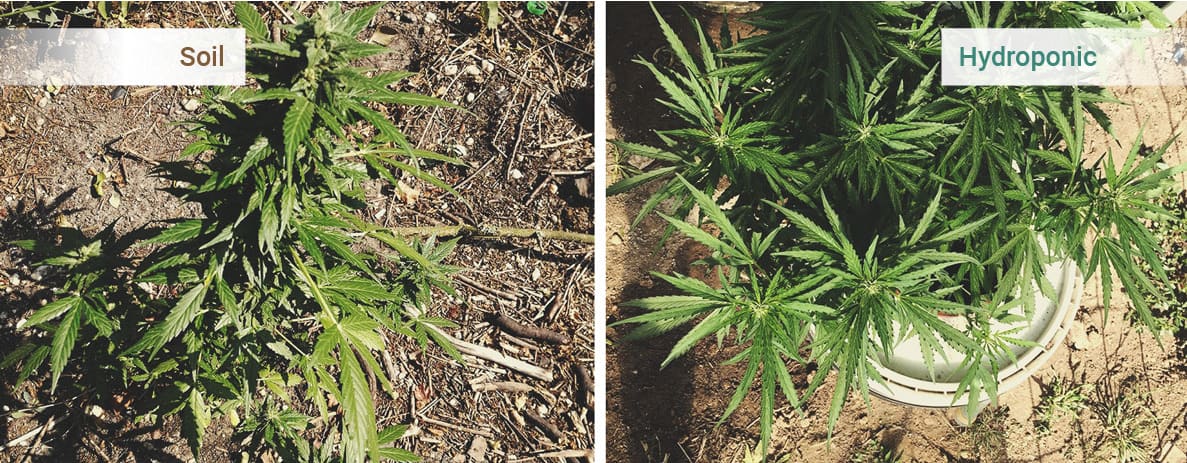
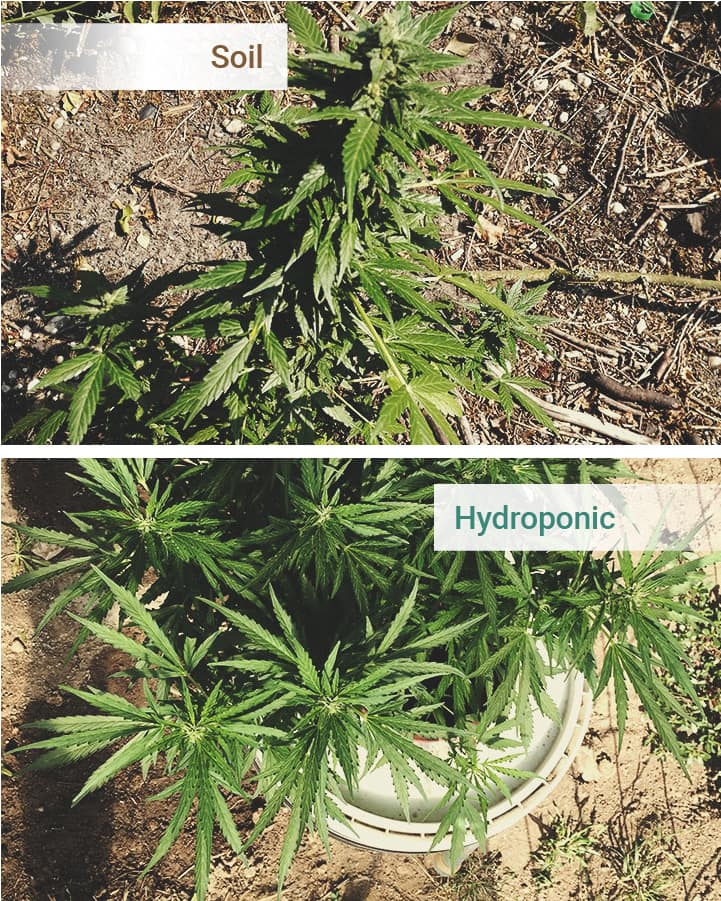
-
Space
Both soil and hydro operations can be scaled down to fit into small places, though not all methods allow for micro-growing. You can successfully grow cannabis in a small container or bucket indoors using soil or the Kratky method. But larger hydro systems will start to cause issues. If you’re growing in a larger indoor space, you have more room for complex hydro systems with external reservoirs—room you likely won't need if growing a few plants in soil.
-
Difficulty
If you have zero experience, or if you’ve grown a few vegetables here and there in the past, growing in soil will prove to be less of a learning curve. There’s something intuitive to sowing seeds in soil, and most high-quality potting mixes allow some room for error when it comes to nutrients and feeding.
The Kratky method and DWC serve as the easiest starting point for beginner hydro growers. These systems are compact, basic, and take up little room. The ability to depend entirely on bottled formulas makes feeding easy.
Complex hydro systems are more difficult than growing in soil. Investing in the right gear and setting up these systems requires a good amount of research. Plus, you’ll need to maintain the system during the grow, and clean and repair it in between operations.
-
Speed
Hydroponic plants typically grow faster than those in soil. Plants growing in a soil medium rely on the biological activity of soil life to free up nutrients before they can be absorbed by the roots. Although adding synthetic fertilisers speed up the process, the soil still acts as a buffer, and not all of these inputs stay around in the rhizosphere (root zone) very long. In contrast, hydroponic nutrients are constantly or very regularly available to plant roots and confined to a set space, resulting in faster growth during the vegetative phase.
Therefore, if you're looking for the quickest harvest possible from a photoperiod cannabis strain, it may be best to go with hydro. On the other hand, you can select autoflower genetics, which will flower after just a few weeks of veg, regardless of whether you use soil or hydro.
-
Yield
The final yield from a soil or hydro grow depends on several variables. Growing autoflower cannabis genetics in a small container of soil will yield less compared to a large hydro system housing huge sativa plants. Likewise, a small Kratky container won’t provide the same harvest as a plant grown directly in rich soil outdoors.
However, experienced hydroponic cannabis growers often report larger yields from hydro plants than soil-grown plants under the same conditions. Hydro plants tend to display faster and more vigorous growth during the vegetative stage, which results in the formation of more bud sites. Combine this with genetics predisposed to producing large and heavy colas, and you’ll find yourself harvesting substantial yields every time.
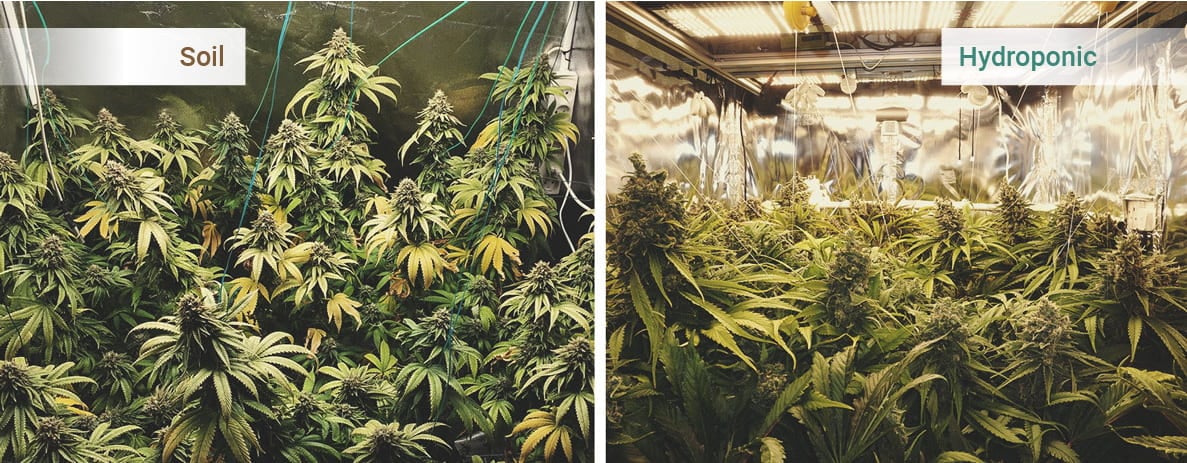
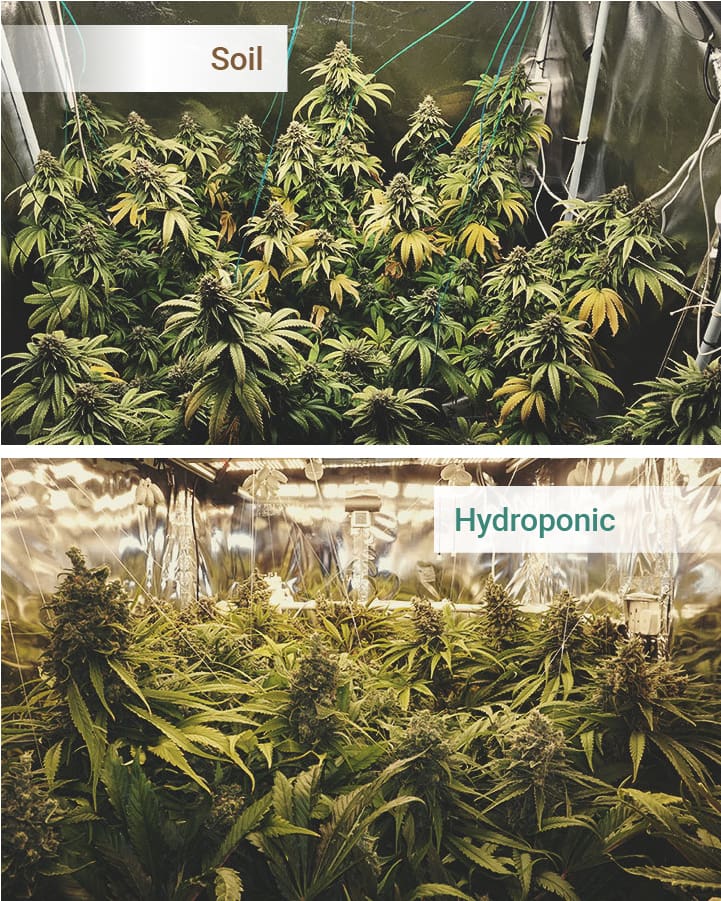
-
Quality
Both high-quality and low-quality plants can come out of soil and hydro systems. Again, the quality of cannabis has less to do with the growing medium and more to do with genetics and management. These factors hold far more sway over the quality of the end product. The environment, i.e. indoors vs outdoors, has more of an influence on factors such as terpene and cannabinoid production due to the potential influence of UV rays on the biosynthesis of these compounds.
-
Water Consumption
Counterintuitively, hydroponic setups actually use up to 90% less water than soil. Certain hydro systems recirculate water, whereas others house a small supply in a single container throughout the entire grow. Although some systems require topping up, growers end up losing less water than they do when cultivating in soil, where water runoff is the name of the game.
-
Pest Pressure
Both hydro and soil plants are more predisposed to pest pressure when grown outdoors. Indoors, soil plants are still prone to pest issues—bringing soil indoors can introduce eggs and live pests into the growing environment. Indoor hydroponic plants are certainly not pest-proof either, but they’re less likely to fall prey to an infestation indoors.
These Strains Are A Great Place To Start
Whether you choose soil or hydroponics, both are capable of producing top-quality cannabis. However, if you are not sure which strain to start with, we have a beginner-friendly suggestion for both methods.
-
Soil
Soil is the traditional growing medium that has served growers for centuries. As we have alluded to though, soil can be a little tricky to manage, especially if it is your first time cultivating cannabis. With that in mind, we have picked a strain that is more forgiving than others to offset any small mistakes.
Somango XL
This flavorsome beauty benefits from indica-dominant genetics, and can be harvested in as little as nine weeks. Not only is that less time for things to go wrong, but Somango XL is considered ideal for both newbie and experienced growers. Her hardiness allows simple mistakes like nutrient fluctuation to occur without significant repercussions.
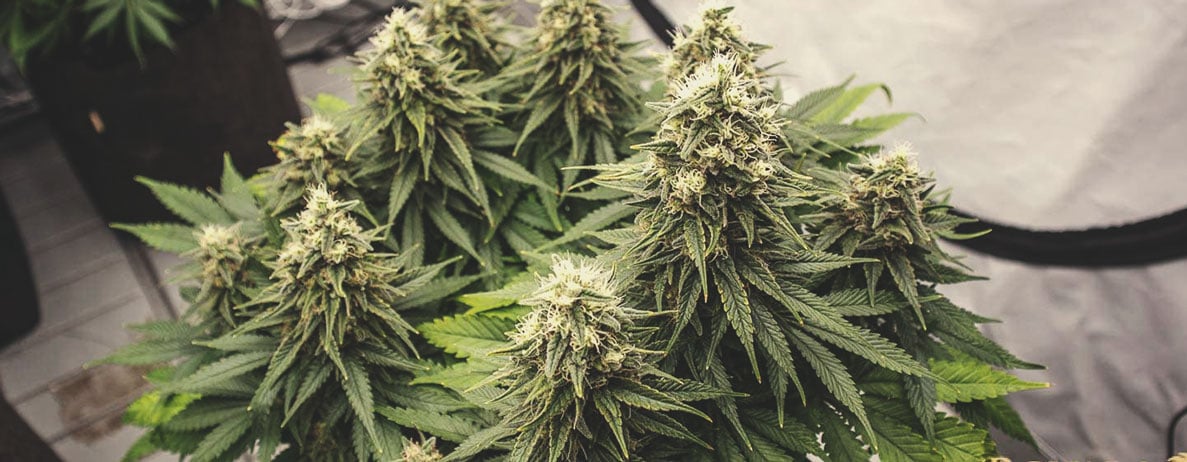
Somango XL
|
|
Somango x Critical 47 |
|
|
18 to 20 oz/m² |
|
|
2 to 3 feet |
|
|
8 - 10 weeks |
|
|
THC: 18% |
|
|
Sativa 25% Indica 75% |
|
|
19 to 21 oz/plant |
|
|
4 to 7 feet |
|
|
Late September |
|
|
Powerful , Stoned |
-
Hydroponics
Get hydroponics right, and it allows for some genuinely monstrous results. With complete control over everything your cannabis needs, managing the height of your towering beauty can become a real struggle. Our recommended strain for hydroponic growers takes this into account, without impacting yields or flavor.
Wedding Gelato
Treat this “sickly sweet” lady right, and she will return the devotion with 20–25% THC. In hydroponics, the growth potential of a strain is a serious consideration. Wedding Gelato is ideal because she only reaches 2 – 3.3 feet in height. The precision of hydroponics allows all of her efforts to go into developing dense, THC laden buds, rather than growing out of control.
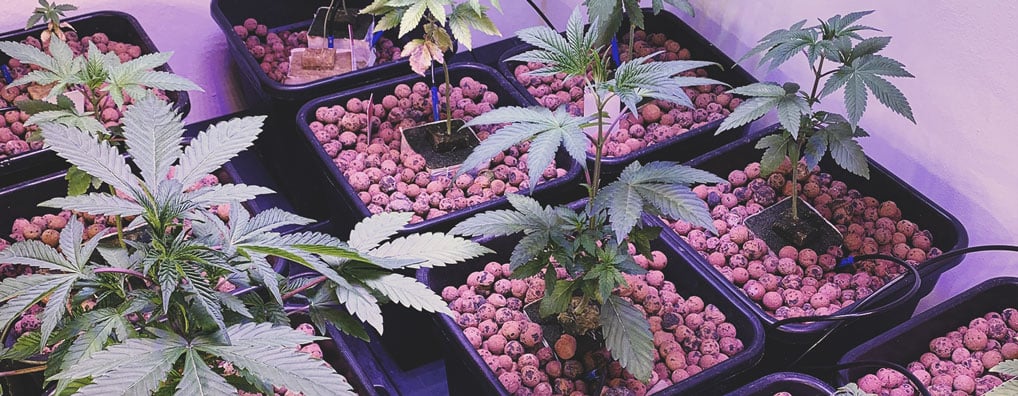
Wedding Gelato
|
|
Wedding Cake x Gelato x Gelato 33 |
|
|
16 to 19 oz/m² |
|
|
2 to 3 feet |
|
|
8 - 10 weeks |
|
|
THC: 25% |
|
|
Sativa 40% Indica 60% |
|
|
12 to 14 oz/plant |
|
|
4 to 7 feet |
|
|
Early October |
|
|
Calming, Euphoric, Physically Relaxing, Uplifting |
Soil vs Hydroponic Cannabis: Which Do You Choose?
There you have it. You’re now aware of the biggest differences, and similarities, between hydro and soil growing. While these techniques don’t have much sway over yield or quality compared to other variables, they are very different when it comes to feeding and management. Thankfully, you can achieve excellent results in both indoor and outdoor environments. While soil allows growers more room for error in terms of feeding, and a more hands-off approach when using mulch and no-till approaches, hydro uses less water overall. So, which cultivation path will you tread?


























